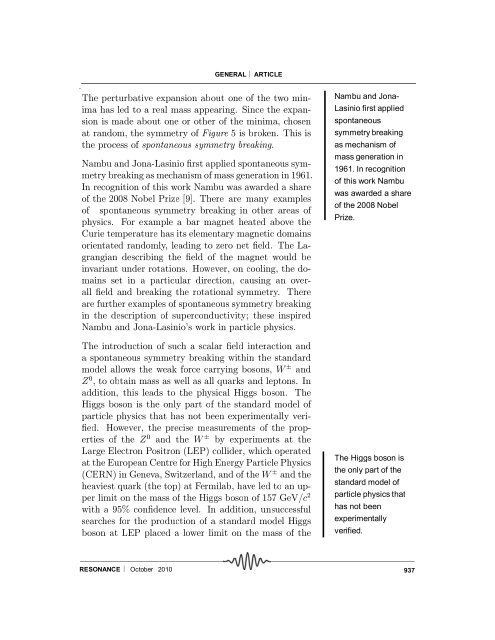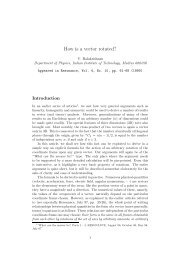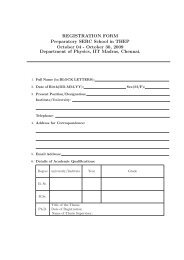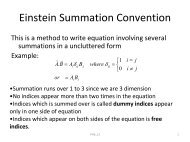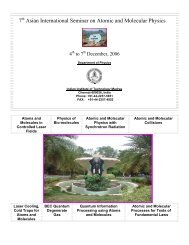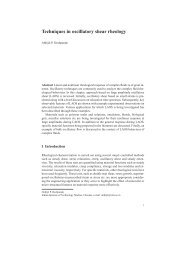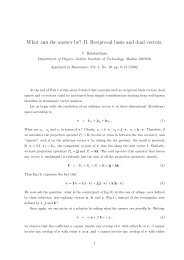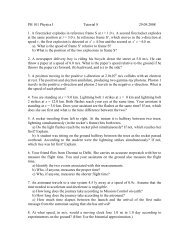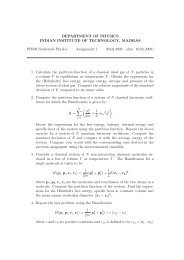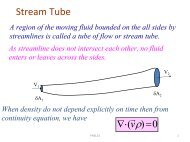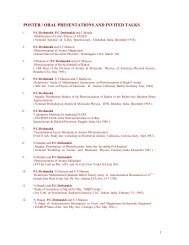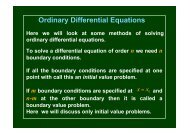Symmetry Principles and Conservation Laws in Atomic and ...
Symmetry Principles and Conservation Laws in Atomic and ...
Symmetry Principles and Conservation Laws in Atomic and ...
You also want an ePaper? Increase the reach of your titles
YUMPU automatically turns print PDFs into web optimized ePapers that Google loves.
GENERAL ARTICLEThe perturbative expansion about one of the two m<strong>in</strong>imahas led to a real mass appear<strong>in</strong>g. S<strong>in</strong>ce the expansionis made about one or other of the m<strong>in</strong>ima, chosenat r<strong>and</strong>om, the symmetry of Figure 5 is broken. This isthe process of spontaneous symmetry break<strong>in</strong>g.Nambu <strong>and</strong> Jona-Las<strong>in</strong>io ¯rst applied spontaneous symmetrybreak<strong>in</strong>g as mechanism of mass generation <strong>in</strong> 1961.In recognition of this work Nambu was awarded a shareof the 2008 Nobel Prize [9]. There are many examplesof spontaneous symmetry break<strong>in</strong>g <strong>in</strong> other areas ofphysics. For example a bar magnet heated above theCurie temperature has its elementary magnetic doma<strong>in</strong>sorientated r<strong>and</strong>omly, lead<strong>in</strong>g to zero net ¯eld. The Lagrangi<strong>and</strong>escrib<strong>in</strong>g the ¯eld of the magnet would be<strong>in</strong>variant under rotations. However, on cool<strong>in</strong>g, the doma<strong>in</strong>sset <strong>in</strong> a particular direction, caus<strong>in</strong>g an overall¯eld <strong>and</strong> break<strong>in</strong>g the rotational symmetry. Thereare further examples of spontaneous symmetry break<strong>in</strong>g<strong>in</strong> the description of superconductivity; these <strong>in</strong>spiredNambu <strong>and</strong> Jona-Las<strong>in</strong>io's work <strong>in</strong> particle physics.The <strong>in</strong>troduction of such a scalar ¯eld <strong>in</strong>teraction <strong>and</strong>a spontaneous symmetry break<strong>in</strong>g with<strong>in</strong> the st<strong>and</strong>ardmodel allows the weak force carry<strong>in</strong>g bosons, W § <strong>and</strong>Z 0 , to obta<strong>in</strong> mass as well as all quarks <strong>and</strong> leptons. Inaddition, this leads to the physical Higgs boson. TheHiggs boson is the only part of the st<strong>and</strong>ard model ofparticle physics that has not been experimentally veri-¯ed. However, the precise measurements of the propertiesof the Z 0 <strong>and</strong> the W § by experiments at theLarge Electron Positron (LEP) collider, which operatedat the European Centre for High Energy Particle Physics(CERN) <strong>in</strong> Geneva, Switzerl<strong>and</strong>, <strong>and</strong> of the W § <strong>and</strong> theheaviest quark (the top) at Fermilab, have led to an upperlimit on the mass of the Higgs boson of 157 GeV=c 2with a 95% con¯dence level. In addition, unsuccessfulsearches for the production of a st<strong>and</strong>ard model Higgsboson at LEP placed a lower limit on the mass of theNambu <strong>and</strong> Jona-Las<strong>in</strong>io first appliedspontaneoussymmetry break<strong>in</strong>gas mechanism ofmass generation <strong>in</strong>1961. In recognitionof this work Nambuwas awarded a shareof the 2008 NobelPrize.The Higgs boson isthe only part of thest<strong>and</strong>ard model ofparticle physics thathas not beenexperimentallyverified.RESONANCE October 2010937


